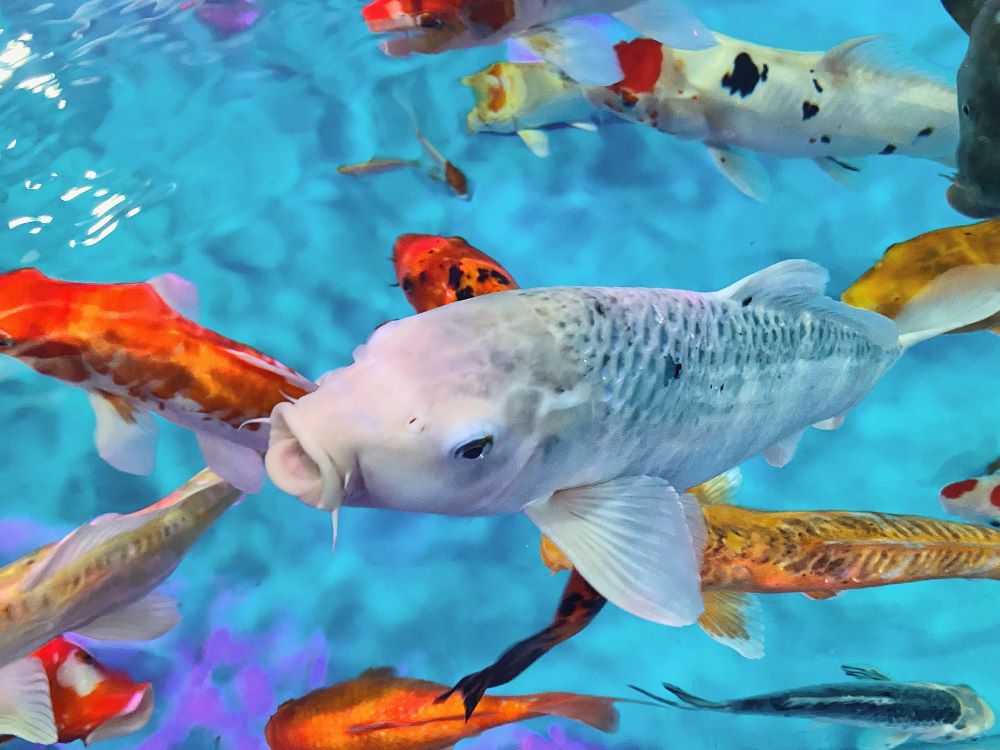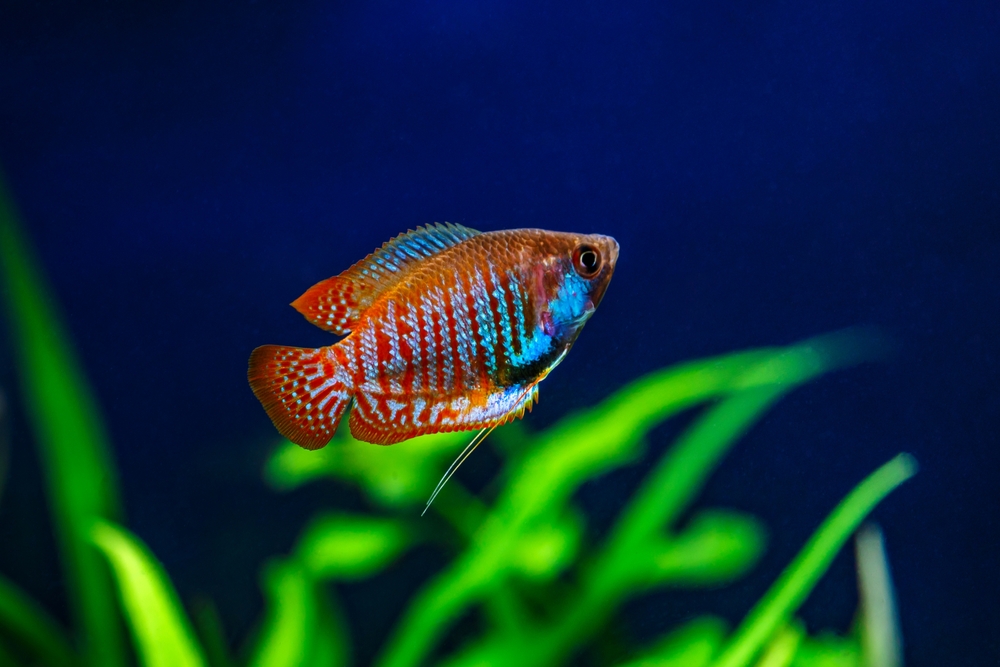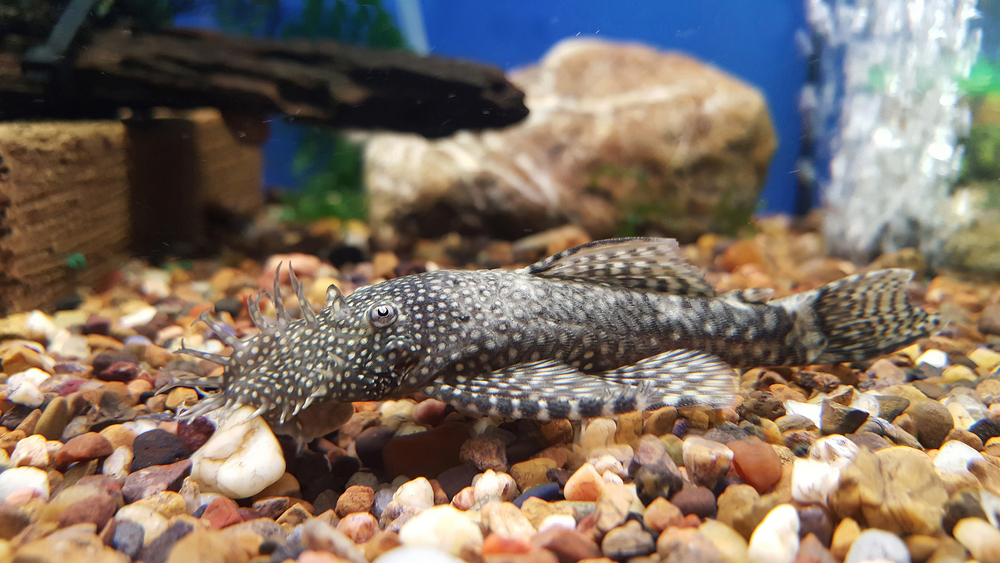15+ Popular Fish with Big Eyes
When you purchase through links on our site, we may earn a commission. Here’s how it works.
With north of 35,000 species of fish already researched by scientists – and potentially tens of thousands of more still yet undiscovered – it’s no surprise that some fish have pretty odd looks and unique characteristics.
Some fish have extremely long bodies, others are short and stout. Some are big whopper fish (going hundreds of pounds effortlessly), and some are so small that you’d miss them with the naked eye.
Table of Contents
And then of course you have fish with big eyes – huge eyes – that stand apart from all other fish pretty effortlessly.
That’s what our detailed guide below deals with, fish with some of the biggest eyes underwater!
Popular Fish with Big Eyes
More similar posts:
1. Telescope Goldfish
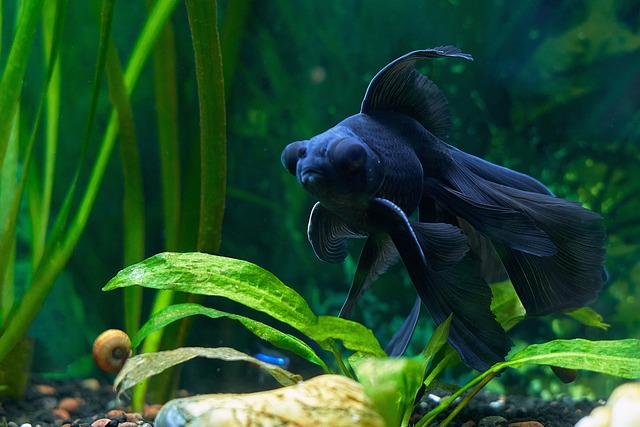
Telescope goldfish look a lot like “regular” goldfish, except for the telescoping eyeballs that bulge out of both sides of their head.
Developed in China throughout the early to middle 1700s, these fish were specifically bred to have big, bulky eyeballs. The look, though, does not translate to better eyesight performance (believe it or not)!
These fish are some of the most popular fish on the planet to keep in home aquariums and for good reason. Their eyeballs and their personality make them perfect pets.
2. Pufferfish
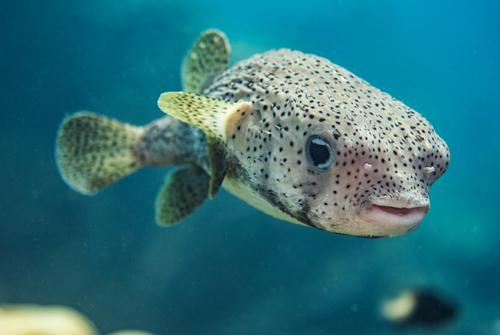
Don’t get fooled into thinking that puffer fish are somehow weak, feeble, or foolish fish. Nothing could be further from the truth.
While these fish do look a little silly (which is a big part of why they are such a popular add to home aquariums), they are actually pretty smart, pretty crafty, and have exceptional eyesight thanks to those big, bulging eyeballs.
Their eyeballs are a major part of their survival system. It allows them to identify threats but also helps them to find food in a hurry. When they puff up their eyeballs get even bigger, if you can imagine that!
3. Rockfish
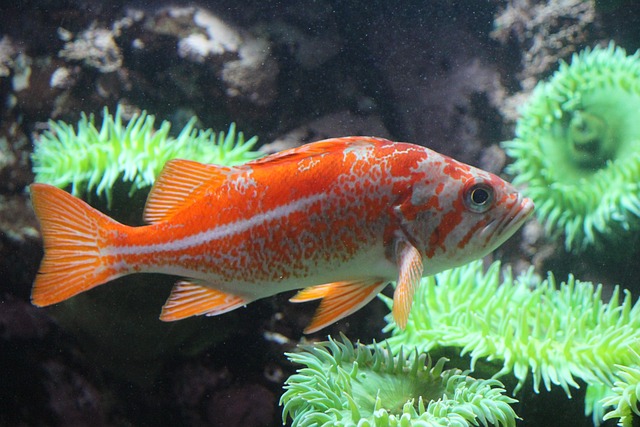
Because of the unique physiology of rockfish they don’t look like they have very big eyes at all when they are underwater.
As soon as you take them out of the ocean, though, their eyes bulge out into almost telescopic proportions – and it’s all because of a unique swim bladder that they have.
When underwater, the gas pressure in the swim bladder of the rockfish maintains the same kind of pressure as the water around them. This allows rockfish to get to some pretty extreme depths. We are talking about 9000 feet or deeper, even.
When these fish, up to the surface (or breach the surface), though, their bladder doesn’t work to equalize pressure any longer and they start to get really bulging proportions.
4. Bigeye Fish
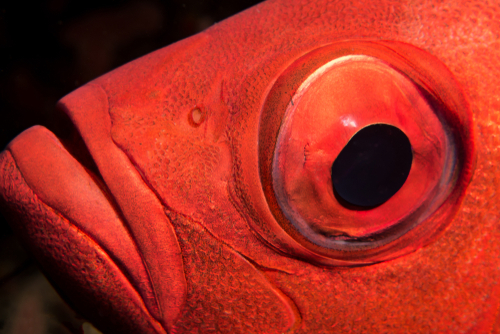
To the surprise of absolutely no one, the bigeye fish – sometimes just called “bigeye” – have a pretty decent sized set of ocular hardware on both sides of their head!
These fish might not look like the most effective or efficient underwater hunters in the ocean today, but the oversized eyeballs that they have allow them to pretty effortlessly hunt for prey – especially at night, when they do very well.
You’ll usually find these fish in the tropical and subtropical waters of the Pacific Ocean, though there are four subspecies of the bigeye that love to spend time in the Atlantic Ocean, too.
This fish is a survivor through and through, and their large eyeballs have helped them to stay on planet Earth for more than 50 million years.
5. Spotted Ratfish

Casual observers of a spotted redfish might be under the impression that these fish are stingrays – until they get a look at the gigantic eyeballs on this fish.
These fish have the body of a stingray, the mobility of a stingray, and a lot of the same behaviors of a stingray, too. When you see that big set of eyeballs upfront, though, you know you’re dealing with a ratfish.
6. Squirrel Fish
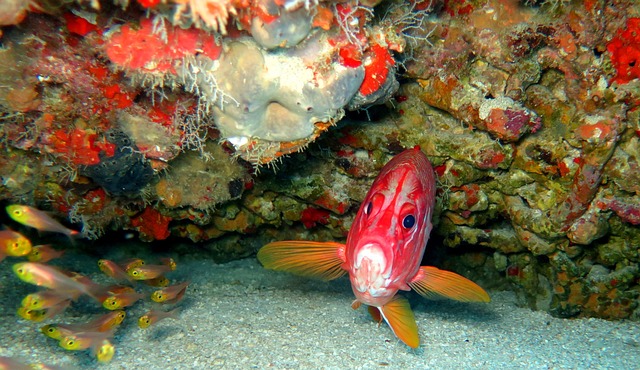
Squirrel fish get their name (interestingly enough) from a world-famous Chinese dish that uses this fish as a core ingredient, but also because of the oversized eyeballs this fish has that resemble the eyeballs of a squirrel.
These fish are caught for two reasons primarily – they are either caught by commercial fishing operations for food (like we mentioned a moment ago) or are captured and kept in aquariums to be sold as pets all over the world.
Squirrel fish found around coral reefs usually have bright, interesting, and almost luminescent colors. Their exceptional eyesight allows them to see well even in the dark.
7. Tarpon
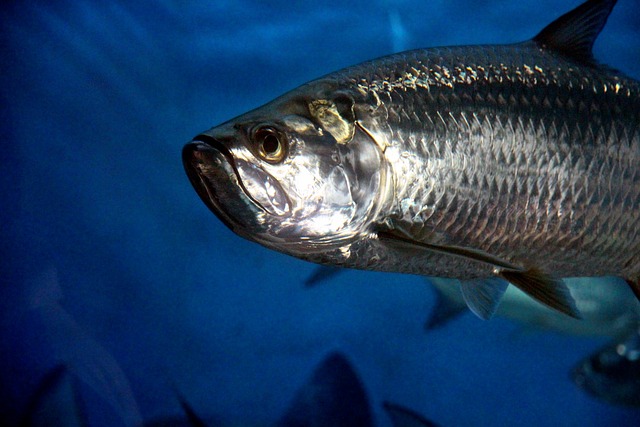
Native to the salty and brackish waters of Florida, tarpon are oversized fish that not only have an almost armor like composition of scales to protect them but also oversized eyeballs that help them see better in low light conditions – protecting them from natural predators.
Of course, these oversized eyeballs also help Tarpon be more effective underwater predators themselves in these less than ideal water conditions. Over time, though, there eyesight fades and their eyes actually get smaller, leading older tarpon closer to the surface.
8. Horse-Eye Jack

Horse eye jack (sometimes called bigeye jack) are chubby, almost club looking fish that are beloved for their sport fishing “liveliness” but are also a big-time part of the commercial fishing industry everywhere they are found naturally.
This large eyed fish was first discovered and classified all the way back in 1831 when a Swiss naturalist was examining an example of this fish that had been brought back from Brazil.
Large, these fish can grow to 3.3 feet on average – and often considerably larger than that. Horse eye jack fish can also get to 30 pounds or so pretty consistently, with larger versions caught with regularity.
Sport fishermen and commercial fishing operations have pulled monster horse eye out of the waters of South America for years.
9. Blue Sharks
Blue sharks (sometimes called great blue sharks) are apex predators that swim in deep water in most of the world’s temperate and tropical ocean waters.
Reaching about 10 feet in length (on average), these sharks like the depths because of the colder temperatures – and they aren’t afraid of migrating to find water temperatures that really suit them perfectly.
For example, it’s not at all uncommon for blue sharks to be found in New England and then later found in South America – the same blue sharks, that is!
10. Genie’s Dogfish
This species of shark has a pretty unique history, having really only been “discovered” in 2018.
Originally this big eyed fish was thought to be part of a larger shark species. Deeper research, though, proved that this fish was completely distinct and separate from other sharks – and it was named in honor of Eugenie Clark, one of the foremost fish researchers on the planet.
Not too terribly much is known about this species of shark right now (no surprise there). Currently researchers believe that these sharks grow to be anywhere between 20 inches and 28 inches long or so, have larger eyes designed to see in deep and dark water, and are (obviously) a carnivorous fish.
11. Barracudas

While most folks think of barracuda as being incredibly aggressive, borderline ferocious, and downright dangerous fish with razor-sharp teeth they often don’t think about just how big their eyes are (or how good their eyesight is, for that matter).
As predatory a fish as you’re going to find in the ocean today, these fish are almost always found in subtropical and tropical waters ranging from the Atlantic to the Pacific.
Beloved by passionate sport fishing enthusiasts, these fish can grow to be pretty enormous (we are talking about 65 inches long or longer) and are always pretty live on the line.
If you’re lucky enough to hook one and reel it in, though, don’t be surprised if you’re stunned at just how large their eyes really are.
12. Porbeagle Shark
Though these sharks have a bit of a funny name, they are (after all) the smaller cousin of the Great White shark – one of the most ferocious apex predators on planet Earth.
These sharks, though, only grow to be about 7 feet in length (on average) and spend a lot more time in deeper water than their Great White cousins. They have larger eyes to function in deeper, darker waters and do quite well for themselves because of it.
13. Swordfish
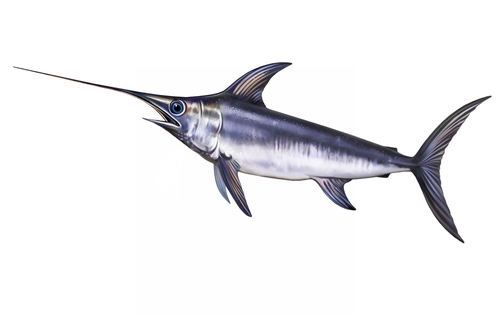
At first glance, swordfish might not look like they have the largest eyeballs in the world. But a lot of that is because of how big the rest of their body is in proportion.
Up close and personal, though, you’ll find that swordfish have gigantic eyeballs – a key part of their ability to hunt so effectively in some of the deeper parts of oceans all around the world.
One of the coolest things about the eyes of swordfish (aside from their size) is their unique ability to detect flickers and flashes of movement faster when the temperature of their eyes are higher.
This is why it’s not uncommon for swordfish to heat their eyes 10° to 15° higher than the water around them, something pretty unique to this fish.
14. Thresher Sharks
One of the largest shark species under the sea, these sharks can get to be almost 20 feet long – and sometimes even longer – but are generally considered to be pretty harmless (as long as you are a human, anyway).
Unlike the Great White and other more aggressive sharks, these large eyeball sharks like to spend their time eating tuna fish, billfish, and herring. They are also known to snack on squids and crustaceans, too.
15. Bigeye Tuna
The odds are pretty good that you heard about bigeye tuna – and have eaten some of it – without even realizing that you have just yet.
That’s because this big eyed fish not only goes by the name “bigeye tuna”, but also by the name ahi tuna (especially in Hawaii). Beloved for its flavor, these fish are a delicacy everywhere they are found around the world.
As far as tuna are concerned, the big guide tuna is a pretty decent sized creature – averaging about 8 feet in length and growing to 400 pounds (and sometimes even heavier than that).
Because of this (and because of their unique, delicious flavor) they are targeted by sport fishermen as well as commercial fishing operations all over the planet.
Why Do Some Fishes Have Big Eyes?

When you look at the ocean’s diverse inhabitants, you’ll notice that some fish stand out with their unusually large peepers. From fish with bulging eyes to those with protruding ones, this distinctive trait is more than just an amusing feature; it’s a fascinating adaptation to their environment. Let’s dive into the reasons behind this intriguing aspect of marine life.
Adaptation to Environment
- Deep Sea Adaptations: In the dark depths of the ocean, light is a scarce commodity. Deep sea fish with big eyes have evolved to maximize the little light available. Their large eyes are more effective at gathering and focusing light, allowing them to see in conditions that would be pitch black to other creatures. This adaptation is crucial for finding food, avoiding predators, and navigating the murky depths.
- Enhanced Field of View: Fish with big eyes often have a wider field of vision. This is particularly beneficial for prey species, as it allows them to spot predators from various angles. Conversely, predatory fish with large eyes can better detect and track their prey, making them more effective hunters.
- Depth Perception: Fish with protruding eyes, often found in shallow waters, benefit from improved depth perception. This is essential for navigating through complex environments like coral reefs, where precision swimming is necessary to avoid obstacles and ambush prey.
- Camouflage and Intimidation: Some fish with funny eyes use their appearance as a defense mechanism. Large eyes can be intimidating to potential predators, making them think twice before attacking. In other cases, those big eyes blend into their environment, aiding in camouflage.
Survival Mechanism
- Nighttime Hunting: Many fish with big eyes are nocturnal hunters. Their enhanced vision allows them to see clearly in the dark, giving them an advantage over prey that relies on daylight.
- Signaling and Communication: In some species, big eyes play a role in communication and mating rituals. The size or color of the eyes can be a signal of health and vitality, attracting mates or deterring rivals.
- Adaptation to Prey: Fish that feed on small, fast-moving prey often develop large eyes. This helps them accurately judge distances and speed, making them more efficient hunters.
In conclusion, the intriguing feature of fish with big eyes is a remarkable testament to nature’s adaptability. Whether it’s the deep sea fish with big eyes navigating the dark waters or the shallow water species using their eyes for depth perception and communication, these adaptations play a crucial role in their survival and success in diverse aquatic environments. Understanding these adaptations not only gives us insight into the lives of these fascinating creatures but also underscores the incredible diversity and complexity of aquatic life.
Closing Thoughts
While we have highlighted 15 of the world’s most interesting fish with large eyeballs above, this list is nowhere near comprehensive.
As we mentioned at the beginning of this detailed guide there are thousands and thousands of different kinds of fish sharing our planet with us, including tens of thousands of species of fish that still haven’t even been discovered yet!
Bigeye fish are some of the most interesting fish to look at, but it’s important to remember that many of them (thanks to those big eyes) are able to spend time looking at you, too.
Frequently Asked Questions
Do big eyes impact the vision of a fish?
The overwhelming majority of fish that have larger eyeballs did in fact evolve this trait to improve their vision, particularly those that spend their time in dark, deep water.
Some fish with large eyeballs (like the telescope goldfish, for example) ended up with bigger eyes but worse eyesight, though.
Are certain types of fish more prone to bigger eyes than others?
Fish that spend a lot of time in deep, dark water are more likely to have larger eyeballs than others. Fish that also spend a lot of time hunting for prey – or staying on the lookout for predators – generally have developed larger eyes as well, giving them an edge and advantage.
My regular eyed fish has big eyes now – what’s going on?
If you have a “regular” eyed fish in an aquarium that suddenly has larger eyeballs – larger than normal, anyway – it’s a good idea to consult a veterinarian and get your hands on some fish medicine you can add to their water.
You’re likely dealing with a bacterial infection you want to clear up ASAP. Ignore this obvious warning sign that something’s wrong and your fish may lose their eyesight or even die because of the infection.

